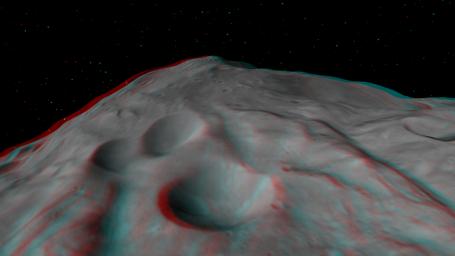3-D Image of the Central Complex in Vesta’s Rheasilvia Impact Basin
Caption:
This 3-D image, called an anaglyph, shows the central complex in Vesta's Rheasilvia impact basin. To create this anaglyph, two differently colored images are superimposed with an offset to create depth. When viewed through red-blue glasses this anaglyph shows a 3-D view of Vesta's surface. The images used to generate the two differently colored images that make up this anaglyph were obtained during the approach phase of NASA's Dawn mission in July 2011. At the time the distance from Dawn to Vesta was about 5,200 kilometers (3,200 miles), which results in an image resolution of about 500 meters (1,600 feet) per pixel. The depth effect or topography differences in this anaglyph were calculated from the shape model of Vesta. North points to the bottom of this anaglyph. The central complex is approximately 200 kilometers (120 miles) in diameter and has approximately 20 kilometers (12 miles) of relief from its base. This makes the central complex about two and a half times taller than Mt. Everest! There are a number of craters of different sizes and preservation states located on the central complex. There are also roughly linear ridges running up along the central complex, which clearly stand out in this anaglyph. These ridges are part of the hummocky (i.e., wavy or undulating) terrain of Vesta's Rheasilvia basin.
Background Info:
The Dawn mission to Vesta and Ceres is managed by NASA's Jet Propulsion Laboratory, a division of the California Institute of Technology in Pasadena, for NASA's Science Mission Directorate, Washington. UCLA is responsible for overall Dawn mission science. The Dawn framing cameras have been developed and built under the leadership of the Max Planck Institute for Solar System Research, Katlenburg-Lindau, Germany, with significant contributions by DLR German Aerospace Center, Institute of Planetary Research, Berlin, and in coordination with the Institute of Computer and Communication Network Engineering, Braunschweig. The framing camera project is funded by the Max Planck Society, DLR, and NASA/JPL.
More information about the Dawn mission is online at
http://www.nasa.gov/dawn
and
http://dawn.jpl.nasa.gov
.
Cataloging Keywords:
| Name |
Value |
Additional Values |
| Target |
4 Vesta |
|
| System |
Main Belt |
|
| Target Type |
Asteroid |
|
| Mission |
Dawn |
|
| Instrument Host |
Dawn |
|
| Host Type |
Orbiter |
|
| Instrument |
Framing Camera (FC) |
|
| Detector |
|
|
| Extra Keywords |
Color, Crater, Impact |
| Acquisition Date |
|
| Release Date |
2012-01-25 |
| Date in Caption |
|
|
| Image Credit |
NASA/JPL-Caltech/UCLA/MPS/DLR/IDA |
| Source |
photojournal.jpl.nasa.gov/catalog/PIA15322 |
| Identifier |
PIA15322 |

 Planetary Data System
Planetary Data System
